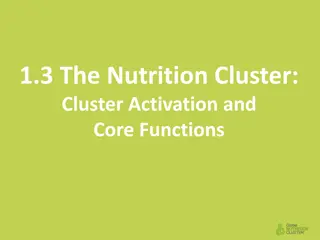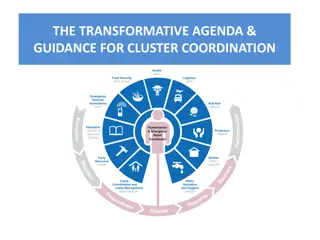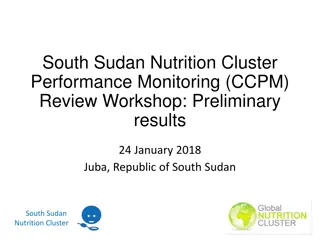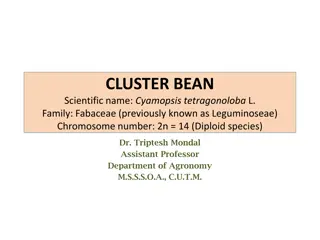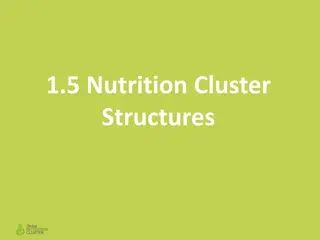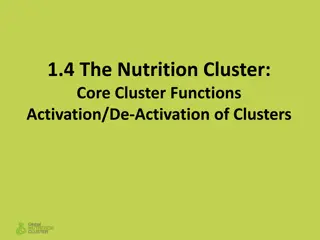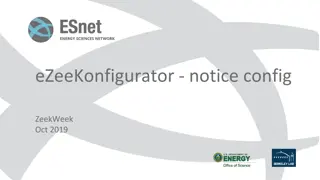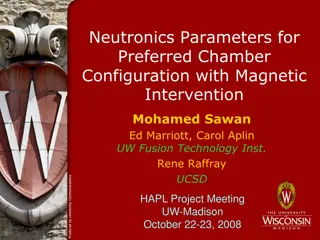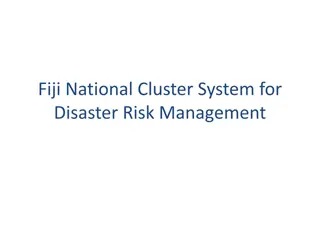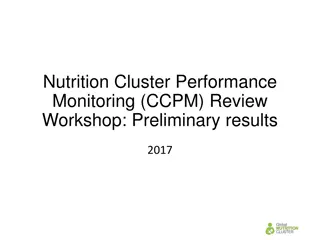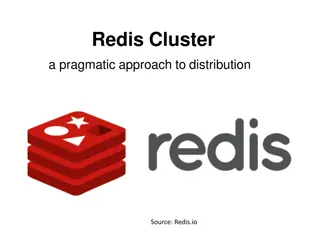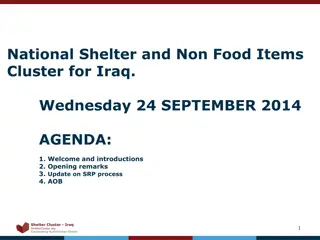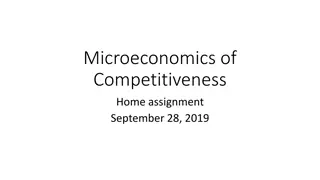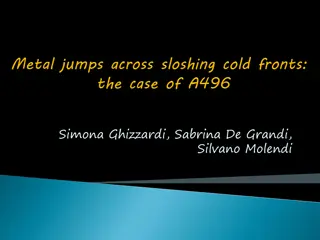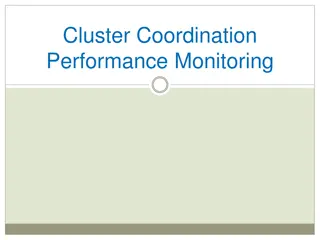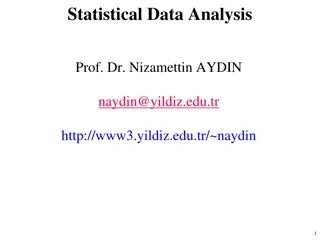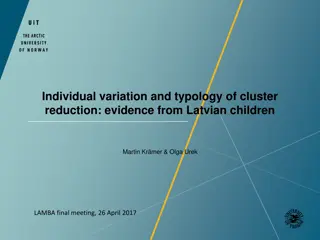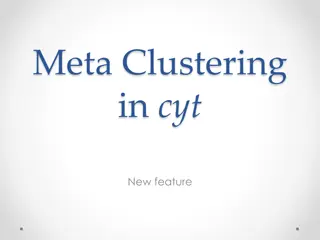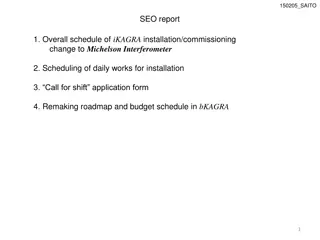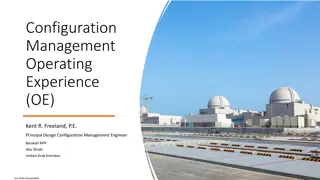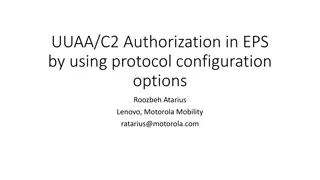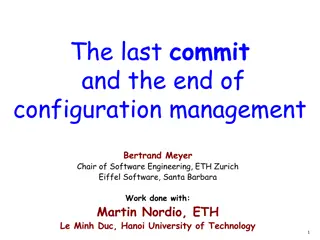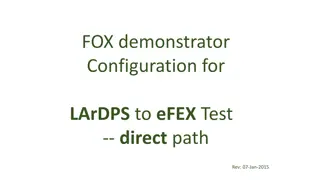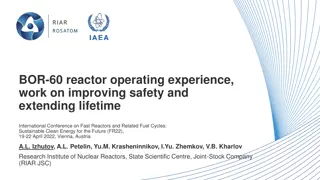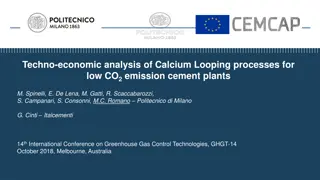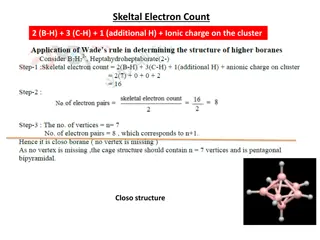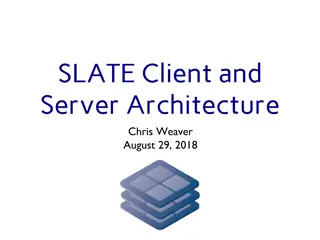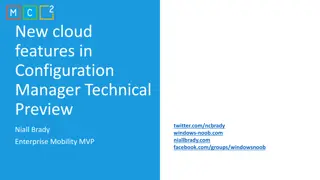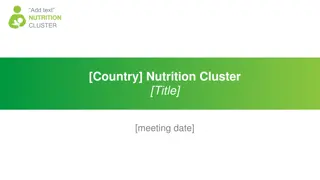Impact of Cluster Configuration on RoCE Application Design
Explore the impact of cluster configuration on Remote Direct Memory Access (RDMA) applications, focusing on achieving low tail latency, high throughput, and low CPU load. Learn about designing and deploying high-performance applications with RDMA technology, including key considerations for configuring RDMA clusters and applications for optimal performance.
Uploaded on Oct 07, 2024 | 0 Views
Download Presentation

Please find below an Image/Link to download the presentation.
The content on the website is provided AS IS for your information and personal use only. It may not be sold, licensed, or shared on other websites without obtaining consent from the author. Download presentation by click this link. If you encounter any issues during the download, it is possible that the publisher has removed the file from their server.
E N D
Presentation Transcript
On the Impact of Cluster Configuration On the Impact of Cluster Configuration on on RoCE RoCE Application Application Design Design Yanfang Le Mojtaba Malekpourshahraki Brent Stephens Aditya Akella Michael M. Swift mmalek3@uic.edu
Designing Designing and and deploying high performance applications deploying high performance applications How to design and deploy applications to have Low tail latency High throughput Low CPU load Ok I found it! RDMA low latency high throughput and under bursty CPU load Remote Direct Memory Access (RDMA) 2
RDMA overview RDMA overview Zero copy Kernel Bypass Protocol Offload RDMA Stack TCP/IP Stack Application Application Application Application User Application Application Congestion Control Congestion Control Presentation Presentation Buffer Buffer Session Session Kernel Transport Transport Driver Driver HW Physical NIC Physical NIC Copy operations TCP/IP procedures Offload congestion control RDMA cluster an applications need to be configured 3
Key question Key question How should I configure my RDMA cluster and application to achieve best performance? 4
Configurations Configurations Decisions Configurations How to transmit data? Design How to handle incoming events? Should applications be co-located? Configurations Deployment Are NICs fair among all applications? Can I use jumbo frames? 5
Design configurations Design configurations sending data options sending data options Design configurations How to transmit data? How to handle incoming events? PCIe PIO operations DMA operations RDMA data packets ACKs of data packets READ RNIC CPU Mem RNIC Mem CPU Pros One network round trip regardless to the structure Cons Transfer just a single memory value Data transfer that needs two memory access (e.g., hash table) 6
Design configurations Design configurations sending data options sending data options Design configurations How to transmit data? How to handle incoming events? PCIe PIO operations DMA operations RDMA data packets ACKs of data packets READ-2 RNIC CPU Mem RNIC Mem CPU Pros Only local CPU is involved 8 B address data Cons Needs multiple round trip What if network is congested? 7
Design configurations Design configurations sending data options sending data options Design configurations How to transmit data? How to handle incoming events? PCIe PIO operations DMA operations RDMA data packets ACKs of data packets WRITE Send /Receive CPU RNIC RNIC CPU CPU RNIC RNIC CPU Combine WRITE/SEND or SEND/SEND 8
Design configurations Design configurations sending data options sending data options Design configurations How to transmit data? How to handle incoming events? PCIe PIO operations DMA operations RDMA data packets ACKs of data packets Compound READ [Kalia, SIGCOMM 14'] CPU RNIC RNIC CPU Pros Only one network transfer is required UC/WRITE Cons Both local and remote CPU are involved UD/SEND What if remote CPU is busy? 9
Design configurations Design configurations Interrupt vs polling Interrupt vs polling Design configurations How to transmit data? How to handle incoming events? CPU Completion Queue Pros No CPU overhead for detecting arrivals Cons Slower reaction to the arrival events 10
Design configurations Design configurations Interrupt Interrupt vs vs polling polling Design configurations How to transmit data? How to handle incoming events? Completion Queue Memory CPU CPU Pros Fast in reacting to a received data Cons CPU is busy for polling memory or CQ 11
Configurations Configurations Decisions Configurations How to transmit data? Design How to handle incoming events? Should applications be co-located? Configurations Deployment Are NICs fair among all applications? Can I use jumbo frames? 12
Deployment configurations Deployment configurations Deployment configurations Should applications be co-located? Applications competing on CPU RDMA applications competing on RNIC Can I use jumbo frames? Co-located applications $$ Separated applications $$$$ 13
Choosing the best configuration Choosing the best configuration Each configure option has its pros and cons There are a lot of options to configure a cluster It is difficult to choose the best configure We need an experiment to compare all different possible configurations 14
Measurement goals Measurement goals Decisions Measurements Configurations How to transmit data? What is the best RDMA verbs? Design How to handle incoming events? Should we use polling or interrupts? Should applications be co-located? What is the effect of applications competing for CPU on RDMA? Configurations Deployment Are NICs fair among all applications? What is the effect of applications competing for RNIC on RDMA? Can I use jumbo frames? What is the effects of frame size on performance? We evaluate RDMA performance to answer to these questions 15
Methodology Methodology Cloud Lab Topology A cluster of 17 servers 8-core ARM Cortex-A57 processor 64 GB of memory 10 GbE Mellanox ConnectX-3 NIC Ethernet switch HP 45XGc Inlined message size 256 B Largest RDMA packet 4 KB Transport (WRITEs, SENDs) Unconnected Total experiment time 10 seconds Traffic patters 16 connections for each server No congestion in the switch Ethernet switch 16 servers 16
Methodology Methodology Test cases READ-Intr READ-Poll WRITE/SEND-Poll SEND/SEND-Intr READ-Intr-? WRITE/SEND-Poll SEND/SEND-Intr CPU RNIC RNIC CPU CPU RNIC RNIC CPU SEND UC/WRITE SEND UD/SEND Read-Intr 2 Read-Poll Read-Intr RNIC RNIC RNIC CPU Mem RNIC Mem CPU CPU Mem RNIC Mem CPU CPU Mem RNIC Mem CPU 8 B address data 17
What to measure? What to measure? Three scenarios Dedicated server for applications Co-located applications competing on CPU Co-located applications competing on RNIC RDMA performance in the terms of Latency Throughput What is the effect of cluster configuration on RDMA performance 18
Which is the best verb? Which is the best verb? Scenario I: No contention READ-Intr READ-Poll Best to fetch large values Best to fetch small values Best verb changes when the payload size changes 19
One side vs two side One side vs two side Scenario I: No contention WRITE/SEND-poll > READ-Intr WRITE/SEND-poll READ-Intr One side verbs are better 20
Effect of RDMA verbs on throughput Effect of RDMA verbs on throughput Scenario I: No contention Similar performance READs slower READs faster Correct verb size depends on the size of the payload 21
Effect of RDMA Effect of RDMA READs on READs on throughput throughput Scenario I: No contention Interrupts or polling has little impact on throughput (No CPU contention) 22
Application needs two memory access Application needs two memory access Scenario I: No contention WRITE/SEND-poll > READ-Intr-2 WRITE/SEND-poll < READ-Intr-2 Best verb changes when the payload size changes 23
Should I use jumbo frames? Should I use jumbo frames? Scenario I: No contention READs are always better Stable latency for small messages Jumbo frames should not be used because they Increase the latency 24
Effect of CPU contention on performance Effect of CPU contention on performance Scenario II: CPU contention READ-poll > READ-intr READ-poll READ-intr CPU contention changes the best verb choice 25
RNIC fairness among short and long messages RNIC fairness among short and long messages Scenario III: RNIC contention Two traffic patterns (Facebook): Storage (4 MB) memcached Starve massages with small payload RNIC contention hurts the throughput of small messages for all verbs 26
Observations Observations Decisions Measurements Results Configurations How to transmit data? What is the best RDMA verbs? Choosing the best performing verb is difficult Design How to handle incoming events? Should we use polling or interrupts? Correct choice depends on the CPU load Should applications be co-located? What is the effect of applications competing for CPU on RDMA? CPU contention changes the best verbs Configurations Deployment RDMA applications do not fairly share the RNIC Are NICs fair among all applications? What is the effect of applications competing for RNIC on RDMA? Can I use jumbo frames? What is the effects of frame size on performance? Never use Jumbo frames because it increases latency Difficult to decide what is best configuration 27
Observations Observations Correct verb choice depends on: Object size CPU utilization RNIC utilization The number of dependent memory accesses Monitor Configure Measure Impossible for application to monitor and measure and adjust verbs 28
high high- -level level library library Needs of a higher-level library Hide complexities from applications Monitor important system parameters Configure the verbs automatically Application Application Application Adaptive Performance Library Monitoring RDMA Verbs Library CPU Overlay Router Optional RNIC Building blocks of the library Existing framework Host Network 29
Conclusion Conclusion We studied The impact of co-located applications contending for RNIC and CPU The impact of large frame sizes hurt tail latency We observed Correct verb choice is dependent on many variables Its impossible for application to monitor and measure all variables Future work Implement the library A higher-level library that hides complexities from applications is needed 30
Thanks for the attention Thanks for the attention Mojtaba Malekpourshahraki Email: mmalek3@uic.edu Website: cs.uic.edu/~mmalekpo 31



